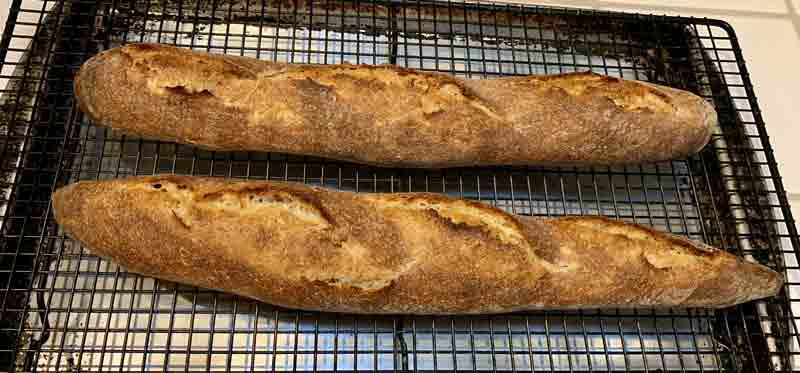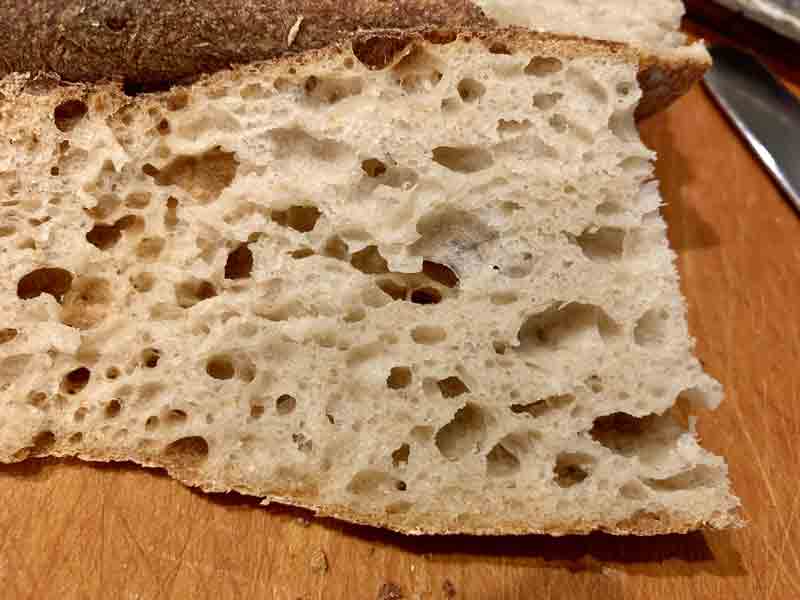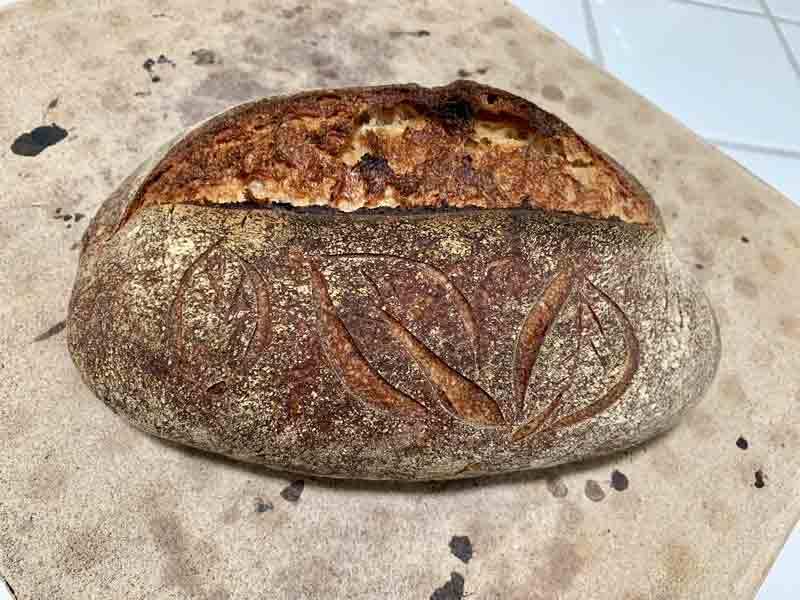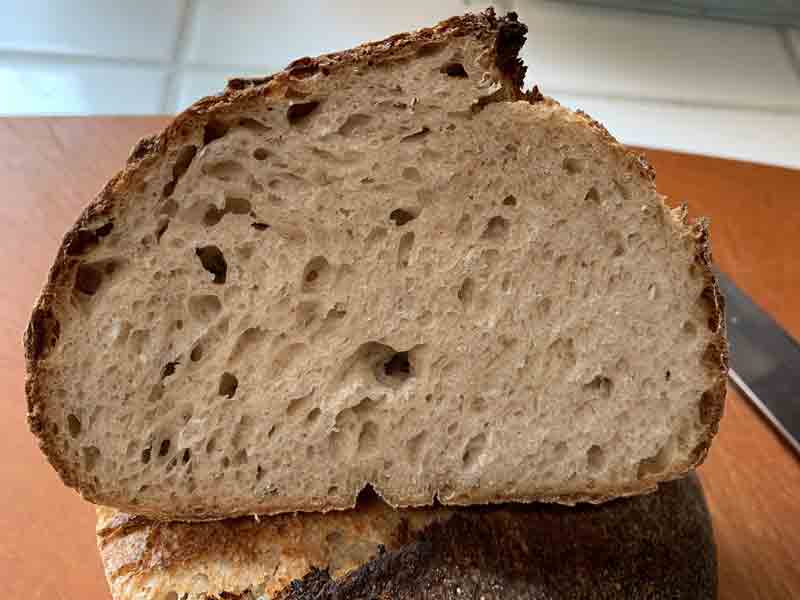
Today's bake 4-8-2019: Another mixed grain Sourdough with a couple tweaks

Sourdough Bread: April 8, 2019
David Snyder
This is another hybrid bread. It differs from my last bake in the following ways:
I substituted a low-protein white whole wheat for the Turkey Red wheat used previously.
I decreased the total dough hydration to 72% because of the lower protein content of the flour mix. At the lower hydration level, the dough was still significantly slacker than the previous bake. It was also remarkably more extensible.
Total Dough | Tot. Flour=1163g |
|
Ingredient | Wt (g) | Bakers' % |
High-protein flour | 147 | 13 |
AP flour | 668 | 57 |
Whole Wheat flour | 116 | 10 |
Whole Rye flour | 116 | 10 |
Whole Kamut flour | 116 | 10 |
Water | 833 | 75 |
Salt | 23 | 2 |
Total | 2019 | 177 |
Starter |
|
|
Ingredient | Wt (g) | Bakers' % |
High-protein flour | 110 | 88 |
Whole Rye flour | 15 | 12 |
Water | 62.5 | 50 |
Firm starter | 62.5 | 50 |
Total | 250 | 200 |
Dissolve the starter in the water.
Add the flours and mix thoroughly.
Ferment at 76ºF for 8-10 hours.
Refrigerate for 12 hours or up to 3 days.
Note: I have maintained my 50% hydration starter with feedings as previously described – a bit of rye and the remainder high-protein flour – with feedings about 3 times per week.
Final Dough |
|
Ingredient | Wt (g) |
AP flour | 668 |
WW flour | 116 |
Whole Rye flour | 96 |
Whole Kamut flour | 116 |
Water | 750 |
Salt | 23 |
Starter | 250 |
Total | 2019 |
Procedures
Place the flours and water in the bowl of a stand mixer and mix at low speed to a shaggy mass.
Cover the bowl and let it rest (autolyse) for 1-2 hours.
Sprinkle the salt over the surface of the dough. Add the starter in chunks. Mix at Speed 1 for 2 minutes to distribute ingredients then for about 9 minutes at Speed 2 to develop the dough.
Transfer the dough to a lightly floured board. Shape into a ball.
Transfer the dough to a clean, lightly oiled bowl. Cover the bowl and ferment at 80ºF for about 3 hours with stretch and folds at 50 and 100 minutes.
Divide the dough as desired and pre-shape as balls. Cover and let rest for 10-30 minutes to relax the gluten.
Shape as boules or bâtards and place in floured bannetons. Cover or place in food-grade plastic bags.
Proof for 2-3 hours at room temperature until the loaves have expanded by about 50%.
Refrigerate for 12-40 hours (The longer the cold retardation, the more sour the final loaf).
Remove from refrigerator. Check on degree of proofing. Proof further at 80ºF, as needed. (May need 1-3 hours.) If adequately proofed, proceed to scoring and baking.
Transfer to a peel. Score as desired.
Bake: If baking in Dutch oven, bake at 475ºF covered for 20 minutes, then uncovered at 450ºF for another 10 minutes or until done to satisfaction.
Bake: If baking on the hearth, pre-heat oven at 500ºF for 1 hour with baking stone and steaming apparatus in place. Turn down oven to 460. Load loaf and steam oven. After 15 minutes, remove steam and continue baking for 20-35 minutes, until loaf is baked. (Depends on size and shape of loaf.)
The bread is done when the crust is nicely colored and the loaf sounds hollow when thumped on the bottom. The internal temperature should be at least 205ºF.
Transfer the bread to a cooling rack and cool thoroughly before slicing.
I divided the dough into two 250g pieces that were shaped as baguettes and baked after proofing for an hour and two 715g pieces which were shaped as bâtards, proofed at room temperature, retarded for 40 hours, proofed at 80ºF for another hour and 45 minutes then baked.
The baguettes were good but lacked in flavor compared to the retarded loaves.


The bâtard had a more complex flavor and was a little tangier. It was missing the unique and prominent flavor I have come to associate with Turkey Red wheat. It is good, but I have come to enjoy the flavor contribute of whole grain red wheat and miss it in this bread. We'll see how it tastes for breakfast tomorrow.


I do want to experiment more with the low-protein white wheat, but perhaps not in a pain de campagne type bread. How about scones?
Happy baking!
David


Comments
I believe that Pain de campagne is the ideal candidate for using a low-protein flour, since flour in Europe and especially in France (birthplace of this bread) is weaker than american flour. Since american all-purpose is similar to bread flour in Europe (not that we classifie flours in the same manner, buy anyway), we use this type of flour in bread all the time :)
Looking great and I am always envious of the beautiful flours that you have over there! If only we could exchange flours across the world without the postage... Kat
to mix up a 32% whole grain loaf with some additional 12% sprouted flour for the wife's weekly pan bread. This time we will go for a longish bulk on the counter and a very long 40 hour shaped retard based on you work.- if it can make it that long:-) We; done David and Happy baking
Very nice bread, David! I especially like the crumb shotin the last image.
You made a statement that interest me. “I have maintained my 50% hydration starter with feedings as previously described – a bit of rye and the remainder high-protein flour – with feedings about 3 times per week.” Are you keeping this starter in the frig? If not, how do you manage feeding the starter only 3 times a week?
Dan
David
David,
I baked this bread over the weekend and came out delicious. The boule was done in the Dutch oven and the batard on steel, does the Dutch oven create that much more heat and stream giving a better ear?
I RT for 1 hour and then CF for 24 hours.
The I didn't have kumut flour so I sub spelt for it.
I’m diggin’ your creative scoring.
Dan
I do find greater oven spring in loaves baked in a DO. Mine are cast iron.
David
Dave
Would you have any recommendations on how to convert this to using commercial yeast. I enjoy this bread a lot but would like to cut down on the time of making it .
Thanks I have included this past weekend bake using the tweak recipe.
Dave
Do you mean eliminate the sourdough starter and just use yeast, or spike the current recipe with yeast? If the former, I have no suggestions. It would be an entirely different bread. If you just want to speed up fermentation, you could add about 1/4 tsp of instant yeast to the dough after the autolyse. You would still have a bulk fermentation of about 2.5 hours at 72ºF.
I have been bulk fermenting in a proofing box set to 80ºF. This speeds up fermentation and still gives excellent flavor. If you add enough yeast to result in a much shorter BF, you would sacrifice flavor, I fear.
David
i guess some things and this bread in particular is worth the wait then.
Dave